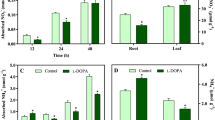Abstract
The structural analog of amino acidl-arginine,l-canavanine (2-amino-4-guanidinooxybutyric acid), is found in 26 cultivars of alfalfa. Its concentration ranges from 6 to 16 mg/g of dry seeds. Canavanine represented more than 70% of the total soluble nitrogen in seeds. Practically all of the canavanine was stored in the cotyledons. Comparison is made of the canavanine content in the cultivars Verko and Europa harvested in different years. During sprouting, 29% of the guanidinooxy compound was translocated into the hypocotyl and radicle in 24 hr. In this early stage of seedling development, the level of the nonprotein amino acid, canavanine, increased threefold whereas the protein amino acid, arginine, as well as asparagine increased 11- and 35-fold, respectively. Two-day-old seedlings are capable of synthesizing canavanine derived from canaline up to 25%. Contrary to this finding in seedlings grown in the time range of 24 days, the guanidino compounds canavanine and arginine were metabolized rapidly, whereas asparagine increased. Furthermore, the toxic canavanine got into the environment of swelled seeds or into the rhizosphere of young seedlings and increased in the milieu to concentrations at 3–57μM. In a biotest, this inhibited the growth of a tomato cell suspension culture as well as the growth of cabbage radicle.
Similar content being viewed by others
References
Bell, E.A., Lackey, J.A., andPolhill, R.M. 1978. Systematic significance of canavanine in the Papilionoideae (Faboideae).Biochem. Syst. Ecol. 6:201–212.
Bickoff, E.M., Kohler, G.O., andSmith, D. 1972. Chemical composition of herbage, pp. 247–282,in C.H. Hanson (ed.). Alfalfa Science and Technology. ASA Inc. Publ., Madison, Wisconsin.
Brune, W., Fabris, D., andJose, S. 1988. The canavanine-pentacyanoamine ferrate complex formation,Ann. Acad. Bras. dene. 60:355–364.
Downum, K.R., Rosenthal, G.A., andCohen, W.S. 1983.l-Argenine andl-canavanine metabolism in jack bean,Canavalia ensiformis (L.) DC. and soybean,Glycine max (L.).Merr. Plant Physiol. 73:965–968.
Fearon, W.A., andBell, E.A. 1955. Canavanine: Detection and occurrence inColutea arborescens.Biochem. J. 59:221.
Fujihara, S., Nakashima, T., Kurogochi, Y., andYamaguchi, M. 1986. Distribution and metabolism of sym-homospermidine and canavaline in the sword bean (Canavalia gladiata cv. Shironata).Plant Physiol. 82:795–800.
Girousse, C., Delrot, S., andBournoville, R. 1991. Sugar and amino acid composition and phloem sap ofMedicago sativa: A comparative study of two collecting methods.Plant Physiol. Biochem. 29:41–48.
Gorski, P.M., Miersch, J., andPloszynski, M. 1991. Production and biological activity of saponins and canavanine in alfalfa seedlings.J. Chem. Ecol. 17:1135–1143.
Grancharov, K., Krauss, G.J., Spassovska, N., Miersch, J., Maneva, L., Mladenova, J., andGolovinsky, E. 1985. Inhibitory effects of pyruvic acid semi- and thiosemicarbazone on the growth of bacteria, yeasts, experimental tumours and plant cells.Pharmazie 40:574–575.
Kasai, T., andSakamura, S. 1986. Reexamination of canavanine disappearance during germination of alfalfa (Medicago sativa).J. Nutr. Sci. Vitaminol. 32:77–82.
Lavin, M. 1986. The occurrence of canavanine in the seeds of the tribe Robiniae.Biochem. Syst. Ecol. 14:71–74.
Miersch, J. 1967. Nachweis und Isolierung von Canalin (2-Amino-4-aminooxybuttersäure).Naturwissenschaften 54:169–170.
Miersch, J., Johlke, C., andSchlee, D. 1988. Zum Canavanin-metabolismus während der Sämlingsentwicklung von Luzerne (Medicago sativa L. cv. Verko).Wiss. Beitr. Univ. Halle 33(S65): 62–71.
Miersch, J., Voynova, J., andGolovinsky, E. 1990. Canavanine in Bulgarian cultivars of alfalfa.Ct. R. Acad. Bulg. Sci. 43:75–76.
Natelson, S. 1985a. Canavanine in alfalfa (Medicago sativa).Experientia 41:257–259.
Natelson, S. 1985b. Canavanine to arginine ratio in alfalfa (Medicago sativa), clover (Trifolium), and the jack bean (Canavalia ensiformis).J. Agric. Food Chem. 33:413–419.
Natelson, S., andBratton, G.R. 1984. Canavanine assay of some alfalfa varieties (Medicago sativa) by fluorescence: Practical procedure for canavanine preparation.Microchem. J. 29:26–43.
Nover, L., Neumann, D., andScharf, K.-D. 1989. Heat Shock and Other Stress Response Systems of Plants. Springer-Verlag Berlin.
Richter, M. 1967. Dissertation. Göttingen.
Rosenthal, G.A. 1972. Investigation of canavanine biochemistry in the jack bean plant,Canavalia ensiformis (L.) DC. II. Canavanine in the developing plant.Plant Physiol. 50:328–331.
Rosenthal, G.A. 1973. The preparation and colorimetric analysis ofl-canaline.Anal. Biochem. 51:354–361.
Rosenthal, G.A. 1977a. The biological effects and mode of action ofl-canavanine, a structural analogue ofl-arginine.Q. Rev. Biol. 52:155–178.
Rosenthal, G.A. 1977b. Nitrogen allocation forl-canavanine synthesis and its relationship to chemical defense of the seed.Biochem. System. Ecol. 5:219–220.
Rosenthal, G.A. 1977c. Preparation and colorimetric analysis ofl-canavanine.Anal. Biochem. 77:147–151.
Rosenthal, G.A. 1990. Metabolism ofl-canavanine andl-canaline in leguminous plants.Plant Physiol. 94:1–3.
Rosenthal, G.A. 1991. The biochemical basis for the deleterious effects ofl-canavanine.Phytochemistry 30:1055–1058.
Rosenthal, G.A., andDahlman, D.L. 1982. A cautionary note on pentcyanoammoniumferrate use for determiningl-canavanine occurring in biological materials.Experientia 38:1034–1035.
Spackman, D.H., Stein, W.H., andMoore, S. 1958. Amino acid analysis.Anal. Chem. 30:1190–1195.
Sugii, M., Miura, H., andNagata, K. 1981. 3-Isoxazolidone from jack bean seedlings.Phytochemistry 20:451–453.
Takahara, K., Nakashini, S., andNatelson, S. 1978. Studies on the reductive cleavage of canavanine and canavaninosuccinic acid.Arch. Biochem. Biophys. 145:85–95.
Töpfer, R., Miersch, J., andReinbothe, H. 1970. Untersuchungen zum Abbau von Canavanin in Fabaceae.Biochem. Physiol. Pf1. 161:231–242.
Tschiersch, B. 1961. Über das Vorkommen von Canavanin.Flora (Jena) 150:87–94.
Weber, E. 1986. Grundriss der biologischen Statistik. Fischer-Verlag, Jena.
Woods, K.R., andWang, K.T. 1967. Separation of dansyl-amino acids by polyamide layer chromatography.Biochim. Biophys. Acta 133:369.
Author information
Authors and Affiliations
Rights and permissions
About this article
Cite this article
Miersch, J., Jühlke, C., Sternkopf, G. et al. Metabolism and exudation of canavanine during development of alfalfa (Medicago sativa L. cv. verko). J Chem Ecol 18, 2117–2129 (1992). https://doi.org/10.1007/BF00981932
Received:
Accepted:
Issue Date:
DOI: https://doi.org/10.1007/BF00981932



